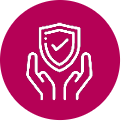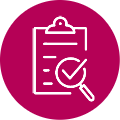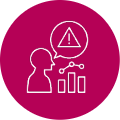
What is ERM?
The Institute of Risk Management (world’s leading professional for ERM
certifications / qualifications with designations upto Fellowship
recognised in over 140 countries) defines Enterprise Risk Management
(ERM) as “an integrated and joined up approach to managing all areas
risks across an organisation and its extended networks.” This means that
ERM goes much beyond the traditional financial risk approach and covers
study of the entire Risk Universe.
According to IRM’s Risk Appetite and
Tolerance Guide, Risk Universe is the full range of risks that could impact,
positively or negatively, on the ability to meet long-term objectives. Furthermore,
the Committee of Sponsoring Organisations (COSO) in its 2004 framework has defined
ERM as “a process, affected by an entity’s board of directors, management and other
personnel, applied in strategy setting and across the enterprise, designed to identify
potential events that may affect the entity, and manage risk to be within its risk
appetite, to provide reasonable assurance regarding the achievement of entity objectives.”
Benefits of a well-implemented ERM program
ERM is important for all companies including startups, MSMEs and large enterprises. It has a range of benefits as listed below:

Strategic Decision Making
By understanding and assessing risks, organizations can make informed strategic decisions that take into account the potential downsides and upsides of various options.

Protection of Assets
Organizations have tangible and intangible assets. ERM helps protect these assets from potential threats, ensuring continuity in operations and safeguarding shareholder value.

Compliance and Regulatory Requirements
Many sectors and organisation types are subject to strict regulatory requirements. ERM ensures that organizations remain compliant, thus avoiding penalties, fines, and reputational damage.

Achievement of Objectives
Every organization has set objectives. ERM ensures that risks which could prevent the organization from achieving these objectives are identified and managed.

Resource Allocation
By understanding the risk profile, organizations can allocate resources (both human and financial) more effectively, ensuring that they are targeting the most significant risks.

Stakeholder Confidence
Stakeholders, be it shareholders, creditors, customers, or employees, have greater confidence in organizations that can demonstrate effective risk management. This can lead to more investment, better credit terms, and improved market reputation.

Early Warning System
An effective ERM system acts as an early warning system, flagging potential issues before they become significant problems, allowing management to take proactive steps.

Reduction of Losses
By identifying and managing risks proactively, organizations can reduce the potential for financial and reputational losses.

Competitive Advantage
Organizations with robust ERM processes can potentially take on more risk than their competitors, if they choose, because they have a better understanding and control over their risk profile. This can lead to faster innovation or market entry.

Improved Organizational Learning
By regularly assessing and managing risks, organizations can learn from both near misses and actual events, leading to continual improvement in their processes and systems.

Fostering a Risk-aware Culture
ERM embeds a risk-aware culture where all employees are tuned to think about risks in their day-to-day activities, leading to more comprehensive risk identification and mitigation at all levels.

Enhanced Shareholder Value
Effective risk management can result in reduced volatility in earnings, leading to more predictable and potentially higher shareholder returns.
In an increasingly volatile and uncertain world, where the pace of change is accelerating, and the potential for both threats and opportunities is growing, ERM provides a structured way for organizations to navigate these challenges, thrive and drive exponential growth by embedding risk-based decision making in every strategy.

Why Study Enterprise Risk Management?
You can start a career in ERM (alongside your current studies or work) with Institute of Risk Management (IRM) - world’s leading professional body for ERM qualifications and examinations recognised across 143 countries. IRM confers the global designations in ERM with Certified Fellowship being the last stage and has one of the largest network of qualified Chief Risk Officers and risk leaders. Pursuing a career in can be rewarding for several reasons:
Growing Demand
In an increasingly interconnected and volatile global environment, organizations are recognizing the importance of ERM. This has led to a growing demand for skilled professionals who can identify, assess, and manage risks effectively.
1
Competitive Salaries
Due to the specialized knowledge and the value ERM professionals bring to an organization, many command competitive salaries and benefits. In India, the average salaries of IRM-certified talent (based on publicly available data and alumni data) ranges from INR 5 lakhs per annum to INR 1.5 crores per annum at CFIRM / Level 5.
2
Broad Scope
ERM offers a broad scope of work, ranging from strategic risks to operational, financial, and hazard risks. This ensures a dynamic work environment where each day can present a new challenge. After passing IRM’s exams, you can choose to work in the industry in the risk department or business department as a risk intelligent domain expert. Further, you can work in risk consulting or setup your own risk management consulting firm, work in due diligence, risk-based research, forensics, climate change, supply chain, cyber risk or digital risk, marketing risk, ESG, governance risk services, startup risk services, risk rating and many more areas. Additionally, you can aspire to become a certified Chief Risk Officer.
3
Strategic Role
ERM professionals often play a strategic role in organizations, working closely with C-level executives and the board. They influence key decisions that have a direct impact on the organization's direction and success.
4
Opportunity for Continuous Learning
The risk landscape is ever-evolving. As an ERM professional, you'll have the opportunity to keep learning about new risks, emerging technologies, regulatory changes, and best practices.
5
Cross-functional Interactions
ERM professionals often interact with multiple departments, from finance and operations to IT and human resources. This provides a holistic view of the organization and an opportunity to understand its various functions.
6
Skill Development
A career in ERM hones a wide range of skills including analytical thinking, complex problem solving, strategic planning, communication, and leadership. These skills are transferable and valuable in many other roles and industries.
7
Global Opportunities
Risks are global in nature, especially for multinational corporations. ERM professionals might have opportunities to work across different geographies and cultures, providing a global perspective.
8
Making a Difference
At its core, ERM is about safeguarding the organization's assets, people, and reputation. It can be satisfying to know that your role has a direct impact on the organization's sustainability and success.
9
Future Leadership Potential
Given their strategic and holistic view of the organization, ERM professionals often possess the knowledge and insights that prepare them for leadership roles in the future
10
Recession Proof
While no job is entirely recession-proof, the nature of risk management makes it a critical function even during economic downturns. Organizations may look to risk managers to navigate challenges and uncertainties during tough times.
11
In summary, a career in ERM offers a combination of challenges, learning opportunities, and rewards that can be very appealing for those who have the right skill set and mindset.

Enterprise Risk Management: Process and Core Areas
ERM encompasses a wide range of activities designed to manage and optimize an organization's risk profile. Here are the core areas of ERM:
1
Risk Governance and Culture:
- Establishing a risk governance structure, including roles and responsibilities.
- Promoting a risk-aware culture throughout the organization.
- Ensuring that risk management objectives align with organizational objectives.
2
Risk Identification
- Detecting and documenting internal and external risks that may impact the organization.
- Using tools and techniques like SWOT analysis, risk workshops, and interviews to identify risks.
3
Risk Assessment and Analysis
- Quantifying and qualifying risks based on their potential impact and likelihood.
- Prioritizing risks to determine the most critical threats and opportunities.
- Utilizing techniques such as risk matrices, risk registers, and scenario analysis.
4
Risk Mitigation and Response
- Developing strategies to address the risks, such as avoiding, transferring, accepting, or mitigating them.
- Designing and implementing controls to manage identified risks.
- Establishing contingency and crisis management plans for high-priority risks.
5
Risk Monitoring and Reporting
- Regularly reviewing and updating the organization's risk profile.
- Monitoring the effectiveness of risk responses and controls.
- Reporting risk status and key metrics to stakeholders, including the board of directors and senior management.
6
Risk Communication
- Ensuring that all stakeholders, both internal and external, are aware of relevant risks and the organization's approach to managing them.
- Facilitating clear and open communication channels to discuss risk-related issues.
7
Emerging and Strategic Risk Management
- Identifying and preparing for new and emerging risks that could affect the organization in the future.
- Aligning risk management with strategic planning and decision-making.
8
Risk Appetite and Tolerance
- Defining the amount and type of risk the organization is willing to accept in pursuit of its objectives.
- Setting risk thresholds and limits for different categories of risk.
9
Risk Integration
- Integrating risk management activities across all functions and levels of the organization.
- Ensuring that risk management is a part of daily operations and strategic planning.
10
Technology and Data Management
- Leveraging technology to automate and enhance risk management activities.
- Ensuring the security, quality, and integrity of risk-related data.
11
Continuous Improvement
- Regularly reviewing and updating the ERM framework, processes, and tools.
- Adapting to changing business environments, regulatory requirements, and best practices.
12
Regulatory and Compliance Management
- Identifying and managing risks associated with non-compliance to regulatory requirements.
- Staying updated with changes in regulations and ensuring the organization is compliant.
These core areas work in conjunction to provide a comprehensive view of an organization's risk landscape, ensuring that risks are proactively managed in alignment with organizational objectives.
Examples of ERM approaches
Enterprise Risk Management (ERM) approaches vary depending on an organization's size, industry, risk appetite, and specific challenges. However, several established ERM approaches and frameworks are widely recognized and adopted. Here are some of the most notable examples:
COSO ERM Framework
- Developed by the Committee of Sponsoring Organizations of the Treadway Commission
(COSO), this framework is titled "Enterprise Risk Management - Integrating with Strategy
and Performance."
- It emphasizes aligning risk appetite with strategy and enhancing
risk response decisions.
ISO 31000:2018 Risk Management
- Developed by the International Organization for Standardization (ISO), this approach provides principles, a framework, and a process for managing any form of risk in a systematic, transparent, and credible manner.
The Basel Accords
- Specifically designed for the banking sector, the Basel Accords (Basel I, II, III) are issued by the Basel Committee on Banking Supervision and focus on risk-based capital standards.
FERMA
- The Federation of European Risk Management Associations (FERMA) has developed a risk management standard that provides a step-by-step approach.
IRM’s Professional Standards in Risk Management
- High standards of competence and integrity are the hallmark of risk management professionals. As the leading professional educational and certifying body for ERM, the IRM plays a leading role in setting these standards. We provide a framework for our qualifications for members’ continued professional development (CPD). The standards set out the knowledge, skills and behaviours required from those working in risk management – that is, what risk professionals should know and what they should be able to do at various levels of their career, alongside the personal qualities and behaviours needed to do the job well. They are flexible enough to accommodate different levels of risk maturity within organisations and the wide range of variations that exist in risk job roles.
The Basel Accords
- Specifically designed for the banking sector, the Basel Accords (Basel I, II, III) are issued by the Basel Committee on Banking Supervision and focus on risk-based capital standards.
FERMA
- The Federation of European Risk Management Associations (FERMA) has developed a risk management standard that provides a step-by-step approach.
Australian/ New Zealand Standard AS/NZS ISO 31000:2009
While it's based on ISO 31000, this standard has specific relevance and applications for the Australian and New Zealand markets.
The FAIR (Factor Analysis of Information Risk) Model
FAIR is a quantitative risk analysis approach, primarily used for cybersecurity and operational risks. It decomposes risks into their underlying elements.
Risk IT Framework
- Developed by ISACA, this framework is designed specifically to manage IT-related risks. It complements ISACA's COBIT framework, which focuses on IT governance and control.
NIST Special Publication 800-37
- Developed by the National Institute of Standards and Technology, this approach is used for risk management in information systems.
APRA Prudential Standards
- The Australian Prudential Regulation Authority (APRA) has established standards and guidelines for risk management in the financial sector in Australia.
Different industries and regions may have their specific risk management standards and approaches. It's essential to select or adapt an approach that aligns with an organization's specific needs, challenges, and objectives. Often, organizations use a combination of these methodologies to create a tailored ERM program that fits their unique risk landscape.
ERM: Risk Maturity Model
Aftering having worked with many organisations (public or private and regulators) across the globe, the IRM has developed a roadmap for companies to achieve Optimised Risk Maturity through its global programmes and certifications. The roadmap focuses on the embedding risk intelligence across the organisation thereby creating an effective risk management culture. The training roadmap is based on IRM’s Risk Maturity Model below. The key objective of the maturity model and training roadmap is to enhance current Risk Management processes and assist organisations to move toward a ‘Proactive/Optimised’ level. Partner with us to elevate your risk culture and develop a robust culture of risk-based decision making.












